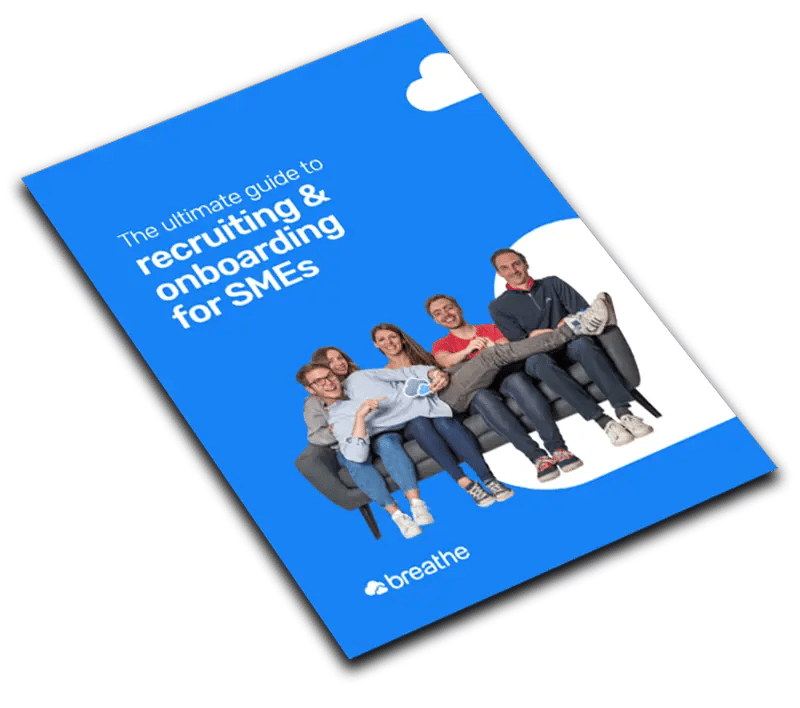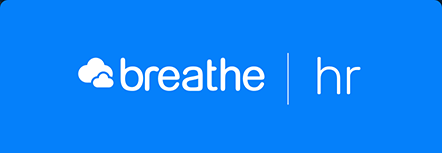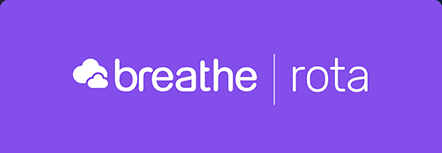The ultimate guide to recruiting & onboarding for SMEs
Download the guide

It’s always incredibly exciting to be reaping the success of your hard work, seeing your business thrive and needing to recruit extra people to support you.
But how do you go about recruiting? And where do you start, especially if you’ve never done it before or don’t have any recruitment specialists to do the work for you?
That’s where we come in. At Breathe, we’re on a mission to support SMEs master their recruitment, people-management & company culture so they can be the best they can be.
That’s why we’ve created this information-packed guide specifically for businesses like yours. Inside, you’ll find everything you need to streamline your recruitment & onboarding process – from understanding when to hire through to crafting the perfect job description, attracting the right people, staying compliant and making a job offer.
This guide is yours to keep, so make sure you keep a copy to hand so you can refer back to it as often as you need to.

As a small business, you’re likely to find yourself needing extra heads as your business grows. That’s where recruitment comes in.
Recruitment is the process of finding the right person for the right role – and at the right time.
Whether it’s your first time hiring, or you already have people working for your business, it’s important you make sure the person you’re taking on are right for the role. You’ll want to ensure they align with your organisational vision and goals.
The recruitment process covers the whole hiring process – from identifying a need to hire all the way through to offering someone a job.

As a small business, you’re likely to find yourself needing extra heads as your business grows. That’s where recruitment comes in.
The recruitment process covers the whole hiring process – from identifying a need to hire all the way through to offering someone a job.
The signs that you need to hire someone new can often be quite clear to see. Here are 5 key things to watch out for:
■ If you don’t have enough people to meet the workload demand, your people may be overworked, overwhelmed & burnt out.
■ If your team is spread too thin, you may find that your customer service is slipping, leading to negative reviews and your reputation declining.
■ Need someone with specific skills? As your business grows, you may find you need to expand your team and hire someone with experience in a particular area. For example, you may need someone to manage your office or help manage your team.
■ If you don’t have enough people working for you, you may find your business missing out on exciting opportunities – like a big new client, partnership or event.
■ If you don’t have the resource, you may find your business is struggling to grow. Taking on someone new – and finding the right person – could help your company meet its goals and achieve more.
You’ll probably have a good feel for how your business is running and know instinctively when it’s time to hire someone new.
But recruiting is something that needs a lot of consideration and can’t be a snap-decision. It’s a big commitment, and if you hire at the wrong time it can have a huge impact on your business – both financially and practically.
Before you go ahead and start drafting a job vacancy, ask yourself these questions:
■ Will the work be seasonal? Will there be enough work to keep them busy all year round?
■ Can my business cope with the temporary drop in productivity while I find, recruit & onboard this new team-member?
■ How much will this new hire cost my business?
■ How will this new hire help my business grow?
■ What’s the job market looking like right now? Is there a shortage of the type of person I need?
■ What are our competitors hiring for at the moment, and what are they offering?

Full time employees work 30 hours or more per week. This is the most common type of employment in the UK – around 75% of the UK’s workers are full-time.
If you take someone on as a permanent full-time employee, you’ll need to provide them with a written statement of employment. This should include their rights, conditions, responsibilities, duties & holiday allowance.
These contracts are very similar to full-time, except they work less than 30 hours per week. Part-time employees don’t always have fixed hours each week – these can be changeable. Zero-hours workers.
This means that a worker is not guaranteed hours each week – instead they are offered hours whenever they’re needed, are free to decline shifts as they want to and are also able to work for other employers.
These contracts are often found in larger organisations within the hospitality industry, as well as health & social care, construction and retail.
Temporary workers are taken on for a specific (and often short) period of time to cover a particular project or time of year. Seasonal workers in supermarkets are a good example of this. Temporary workers don’t tend to receive as many benefits as permanent workers.
Contractors tend to be self-employed and are highly skilled in a specific area. They tend to take on fixed-term contracts to cover a set amount of time – for a project, for example. Most of the time they don’t stay with one employer for too long before moving onto the next one.
An intern is normally a student or trainee who works with you for a short period of time to gain valuable experience in a specific area before getting a permanent job. Internships are sometimes required as part of gaining a qualification, too. Interns sometimes work without pay and usually work around 40 hours a week for a period of 10-12 weeks, but this can vary a lot.
Taking on an apprentice means you’ll be training them from the ground up in a specific area of the business, and they’ll gain a formal qualification at the end. This is accompanied by off-site training – one day at college a week, for example.
Once you’ve identified a need to recruit, you’ll need to nail down exactly what this person would be doing and pull together a job description.
A job description essentially describes the work that will be carried out in a role. It summarises key responsibilities this person will have, as well as the experience and skills needed for the job and who they’d be reporting to. It may also include salary information.
It could also talk a bit about your organisation’s values, culture and the benefits it offers to its people – a job description is a great chance to sell your company to any prospective candidates.
The aim of the job description is to provide the candidate with enough detail to help them determine whether they have the right qualifications and experience for the role.
■ Make the job title clear
■ Use a friendly but direct tone of voice
■ Keep it concise – avoid ‘fluffy’ language & making it too long
■ Be realistic with the workload – don’t ask for too much
■ Involve your current employees in the writing of the job description
Seamless recruitment for small businesses
Job title: [Job title]
Department: [Department name]
Reports to: [Line manager position]
Purpose of role
Why is this role important? What is the end goal of this role? This part doesn’t need to be long – a few bullet points will do.
Responsibilities
List the key things the person in this role will be responsible for and how these contribute to the company’s mission.
The [job title] will be responsible for:
■ [Responsibility 1]
■ [Responsibility 2]
■ [Responsibility 3]
■ [Responsibility 4]
■ [Responsibility 5]
■ [Responsibility 6]
Requirements & preferences
In this section, include a list of must-have requirements in order for the candidate to be successful, as well as a list of preferences that would boost their application.
The [job title] will have the following skills, education & experience:
■ [Requirement 1]
■ [Requirement 2]
■ [Requirement 3]
■ [Requirement 4]
■ [Requirement 5]
■ [Requirement 6]
And here are a few things that are preferable, but not essential:
■ [Preference 1]
■ [Preference 2]
■ [Preference 3]
Salary
The pay bracket for [job title] is [£x - £x] depending on experience.
Our company’s mission
[Company name] is on a mission to help [target market] [describe problem that you’re solving for them] by providing [product/service].

A job advert is quite often the first touch-point candidates will have with your organisation, so it’s important to make an impression.
When writing your advert, make sure you keep it clear and direct. Potential candidates will need to know exactly what the job involves and be able to quickly determine whether it’s right for them.
You’ll need to include:
■ A snappy but attractive job title
■ Details on the job & your company
■ What the job involves, what’s required & what you’ll offer them in return
Once you’ve assessed your company’s needs and have written the job description, you’re ready to get the word out there.
There are a few different places you can advertise a new vacancy:
Before you go for it and start shouting about the new role, you may want to consider opening it up to existing employees first. There are some huge advantages to hiring someone who’s already part of the organisation - they already know your business inside and out, how it’s run and why the role is needed, so would be able to get up and running very quickly.
Introducing an employee referral scheme is a great way to get the right person through the door. Your team know what kind of person is right for your business, so offering them a monetary incentive for recommending successful candidates is a great way to quickly fill a role with the right person for the job.
Shouting about the open vacancy on your website is a great way to attract people who may already be keen to work in your industry – or even for your business.
You can also ensure the job posting is optimised correctly so that Google recognises it as a job.
If you’re active on social media – especially as LinkedIn and Facebook – we’d recommend sharing the new role on your platforms. It’s a great way of reaching people who already follow you (and may even be wanting to work for you) and it makes it easy for your followers to tag their friends if they think it may be a good fit for them.
Best of all – it’s free!
Utilising various job boards is a hugely effective way of attracting the right candidates. Many job boards are super-flexible and have both paid and free options. There are even job boards out there for specific sectors – such as marketing, restaurants & retail. Some popular job boards include:
■ Indeed
■ Reed
■ Monster
■ Totaljobs
■ LinkedIn jobs
■ Jobsite
Now that you’ve advertised the job role and collected a list of applicants, it’s time to go through them and create a shortlist.
Here are our top-tips for shortlisting your candidates:
■ Decide how many people you’d like to interview
Once you have a goal to work towards, things become much easier.
■ Make a list of both essential & desirable qualities
Make two different lists and think about qualifications, education, experience, key skills and abilities. What’s important to you in this person?
■ Try blind applicant screening
To avoid subconscious bias, blind screening can be a useful tool. This means you remove all other data from the CVs and applications and just focus on the key skills, experience and qualifications they have to offer.
■ Score each applicant
As you go, give each person a score out of 10 – this makes it easier to determine the top candidates at the end finalise your shortlist.
■ Let applicants know if they’re not successful
If an applicant doesn’t meet the criteria for the role, it’s a good idea to let them know you’re not moving forward with their application. It’s up to you how you do this – if you have lots of applicants then an email would be quicker and easier, or if you only have a handful you can give them a quick phone call.
Now that you’ve shortlisted some candidates, it’s time to interview them. Here are our top-tips for conducting a successful interview.
1. Help them relax
Interviews are nerve-wracking, so try and help the candidate relax as best you can. Opening the interview with an icebreaker or an informal chat is a great way to ease their nerves. Try and keep the interview conversational rather than asking each question one after the other to keep it flowing nicely and make it less daunting.
2. Plan your questions
Before the interview, make sure you know exactly what you want to ask the candidate. It’s a good idea to ask all candidates the same questions to keep things fair. To see examples of the candidate’s skills in actions, you may consider using competency-based questions.
3. Do your research
Get yourself familiar with the candidate’s CV and what they have to offer. Take some time to understand their journey so far, what they could bring to your organisation and their key skills/qualifications.
4. Leave plenty of time
How much time will you need for the interview? Think about the questions you’d like to cover and make sure you allow enough time, as well as some extra time just in case. This will help both you and the candidate relax.
5. Know what you’re looking for
Make sure you’ve tightened up the person specification and job description for this role before you begin interviewing. If you know exactly what you’re looking for, it’ll be easy to determine whether the candidate is right for the role.
6. Be clear with the candidate
Be open, honest & as clear as possible with the candidate about what the job is, what’s involved and what you’re looking for. This will help the candidate determined whether they’re a good fit for the role.
7. Train your line managers
If another line manager is conducting an interview, we’d recommend you provide them with the right training in interview skills beforehand. This training will make them aware of best practice for interviews and other important factors like the equality act.
8. Sell the job to them
Interviews aren’t just an opportunity for the candidate to show you their potential – it’s also a chance for you to show off your company and tell them why they should want to work for you. Shout about your culture, the benefits you offer and other fantastic perks of working for you.
Great – you’ve found the right person for the role.
The next step is offering them the job, and it’s important you get this bit right. There are a couple of steps you’ll need to follow:
1. Verbal offer
First up, you need to get in touch with the candidate and offer them the job. Normally this is done via a phone call.
2. Written job offer
Once they’ve accepted the offer of employment, you’ll need to send them a formal written job offer. This is usually sent by email and they’ll need to formally accept in response to this. The formal job offer should include:
■ Their full name
■ Job title
■ Salary offered
■ Start date
■ Whether their role is temporary/permanent
■ Benefits & other compensation
■ Probation period
■ Requested documentation – e.g. proof of their right to work in the UK
■ Any other legal background checks that may be required
3. Keeping in touch with unsuccessful candidates
If you have a pot of people who applied for a role but weren’t successful, it may be a good idea to keep them on record in case they’re a good fit for a role that comes up in the future.
With Breathe's Recruitment tool, you can archive applicants for 90 days and keep their details stored securely in the cloud, making it super-simple if you’d like to contact them again regarding another role.
Whilst increasing your headcount can be super-exciting, as an employer you have a few boxes to tick.
The Equality Act 2010 made it illegal to discriminate against people on grounds of certain characteristics or situations.
These include age, gender, sexual orientation, sex, race, religious beliefs, disability, gender reassignment, pregnancy, maternity, marriage and civil partnership.
This works in your business’ favour, too: it’s been proven that businesses with more diverse teams are more successful and those that are less diverse are less successful.
■ Don’t ask questions based on protected criteria(e.g. whether a woman plans to have children or whether their religious beliefs could impact the role)
■ Use non-discriminatory language (e.g. asking for a barmaid suggests you’re only looking for a woman)
■ Avoid unconscious bias (e.g. you may find yourself gravitating towards candidates of the same social/racial background as you). Using the same set of questions across all candidates can help prevent this.
■ Keep track of your decisions with an applicant tracking software (ATS) like Breathe. With Breathe, you can keep a record of your process, notes and rationale, which would support you if a candidate were to accuse you of discrimination.
To stay on top of the latest employment legislations, subscribe to the Breathe blog. We’ll send you a weekly digest of all the latest developments, as well as valuable insights on all things company culture, people-management, leadership & more.
Now that you’ve got everything you need to advertise your role, run successful interviews & find the right person for the job, you’re ready to go.
But have you discovered how software can help make things even easier?
Breathe’s applicant tracking system (ATS) is designed to help SMEs just like you to streamline their recruitment process from start to finish.
With Breathe’s Recruitment tool, you can:
■ Create & publish new vacancies
■ Collect applicants, CVs and documents with a self-service built-in application form
■ Send interview invitations & job offers
■ Pull candidates across to Breathe once they’re hired
■ Offer a great employee experience right from the start
■ Store sensitive information securely in the cloud
■ Save stress, time & paper
Discover Breathe’s Recruitment tool

Onboarding - or the onboarding process - refers to the time after hiring a new employee, until around the time when they pass their probation period. During this time, a new starter learns the company culture, values, vision and gets to know their colleagues - as well as ge
tting to grips with their role.
A successful onboarding programme will help to settle in new starters and to retain talented staff in the long run. Happy staff are more likely to be productive - everyone wins.
1. Start the onboarding process early
Onboarding can - and ideally should - start before your employee’s first day. Whether it’s new starters popping in to say ‘hello’ before they officially join, or inviting them to a social event before their first day, it’s never too early to make introductions and so the new employee starts to feel part of the team.Even sending a welcoming email prior to the new starter’s first day is a good way to begin - this way, the first thing they’ll read is a friendly ‘hello’ from their line manager.
2. Meet the new team
Settling your employee into the team is important to help them feel happy and engaged in their role, as well as building the foundations of good working relationships.
Arranging a team lunch or coffee is a good ice breaker (either in or out of the office) or perhaps you have an upcoming social event that you could invite them to. If your company culture is people-first, teams will go out of their way to make employees feel welcomed and to offer help, where needed.
3. Buddy up
At Breathe, our People Team arrange a ‘buddy system’ where existing employees can volunteer to pair up and check-in with a new starter while they settle in.
This is a great way to help new employees build friendships and working relationships outside of their direct team, which is especially important in their first few weeks when everything might feel a bit daunting.
We also have ‘buddy lunches’ where each new starter goes out to lunch with their buddy to get to know each other better. Breathe ‘buddies’ also give newbies a tour of the office and help with things like making introductions, door codes, remembering people’s names – and most importantly - how to use the coffee machine and where to head for lunch.
There’s enough going on in the first week of a new job without having to worry about what that person’s name is and smiling awkwardly as you walk past. Avoid that scenario by making sure your new employee meets as many people as possible as soon as they can.
4. Be organised
Make sure your new employee knows you’re fully prepared for their arrival. Set up a detailed induction programme including initial tasks to complete, health & safety protocol, a list of company documents & policies to read and other people in the company to meet with.
Take the time to explain the individual roles of each team member within your initial department to help everything start to make a bit more sense. You could gently clarify responsibilities of their role and set the new starter up with some initial tasks or training. Nothing says that you’ve considered your new starter more than ensuring they feel they have a place, rather than feeling like a spare part.
5. Not just a number
It’s important to let your new team member know that they are a valuable addition to the company. You might want to arrange a time for different teams/departments to sit down with your new starter so they can see how the different cogs of the company work. Perhaps a walk-around introduction works best for you if you’re mostly office-based, or you could set up some virtual chats if you tend to work remotely.
Breathe offers new starters a gift box of company-branded items such as a t-shirt, water bottle and some culture-themed books as a way to say “welcome to the team”.
Making a new starter feel welcome is vital, but it will also help with employee retention and making people feel they belong. After all, your people are your culture.
6. Create an environment where people can ask questions
If new employees don’t feel comfortable enough to query things they’re unsure of, then not only is this anxiety-inducing for your newbie, but also a prime situation for mistakes to occur. If you don’t have a culture where asking questions is encouraged, you could be creating a culture of fear.
Create an atmosphere where asking questions and continuous learning is encouraged for all staff.
7. Personalise the onboarding journey
Try to tailor the onboarding process to your new starter as much as you can. Do they learn from listening, watching videos and reading things on their own, or by talking things through with others? Do they need a lot of contact time with their line manager, or is a weekly catch up enough? Perhaps they’d rather a ten-minute daily catch-up, for example, as well as the other training and support you’re offering. They might prefer a one-to-one meeting every fortnight, for instance.
Let your new employee lead on this as much as your company policies allow. This will let them know that you’re putting them first, as well as fostering a working environment that best supports their learning and growth.

Everyone knows that onboarding of new starters is important- but onboarding surveys are still not as common in inductions as the fire drill procedure.
Once you’ve managed to offer a position and get your new employee on-board, it’s a great opportunity to review your onboarding processes. Gaining this type of early feedback is crucial, as your new recruit is seeing your organisation with completely fresh eyes. They aren’t yet used to ‘the way things are done around here’ and so can make useful suggestions that could change the way your organisation works - for the better.
We’ll look at how implementing onboarding surveys for new employees can help your business. We’ve also included some example question prompts- and suggested stages in the onboarding journey that you might want to ask them.
An employee onboarding survey is any type of survey or questionnaire that you ask employees who have recently joined your business to fill out.
There isn’t a set timescale as to when you should ask employees for feedback on the onboarding process - this depends on your organisation, and which stage of the onboarding process you’d most like to gain feedback on.
Most businesses tend to implement onboarding surveys within the first few weeks of your new joiner settling into their role, up until their first six months of employment.
Asking new employees for feedback about the recruitment/onboarding process early on allows you to gain valuable insight into your processes and where you could improve them.
Make it clear that you are open to all feedback- including things that perhaps didn’t work so well or could be better. New employees may not always be as forthcoming with what could be even better next time, for fear of repercussions or making a bad impression.
This feedback could help to develop your recruitment process in unanticipated ways- so be open to the feedback you receive from your newly-onboarded employees.
The 4 C’s of onboarding
If you’ve decided to implement an onboarding survey but are stuck for ideas on what to include, you might consider the 4 C’s of onboarding- compliance, clarification, culture and connection.
It also might be worth asking yourself what you wish you’d been asked when you started your job (or perhaps what you wish was different about your own induction).
If your organisation has a hybrid working policy, you might also use this as an opportunity to ask how this has worked for your new employees, or how it could be improved.

Now that you've got all the information & top tips you need, you’re ready to go away and start building a plan for your recruiting & onboarding process.
Here are some further resources that may be useful to you:
Holiday Entitlement Calculator
.webp?width=535&name=Smiley%20Lady%20with%20cloud@2x%20(1).webp)

Welcome back, log in to your existing Breathe HR account below
Don't have an account? Start a free trial
Did you forget your password?

Welcome back, log in to your existing Breathe Rota account below
Did you forget your password?